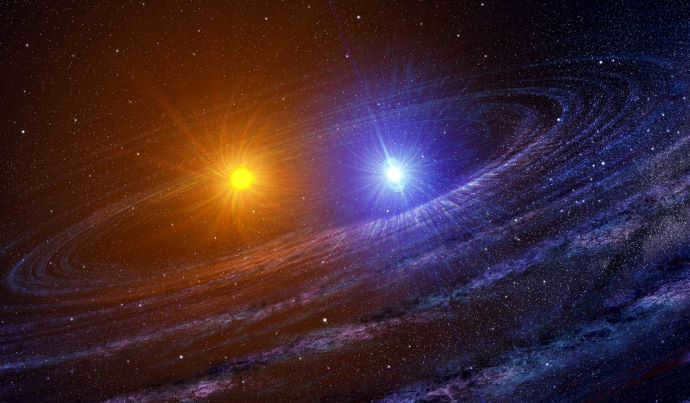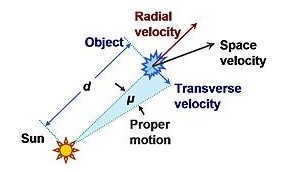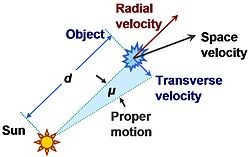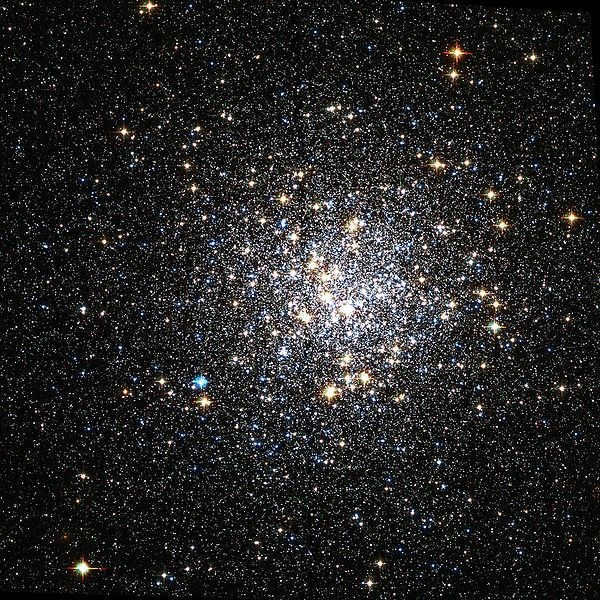
Stellar astronomy focuses on investigating the structure, dynamics, and evolution of stellar systems and subsystems within the Milky Way galaxy, as well as studying the general patterns and regularities that govern them.
The field of stellar astronomy can be further categorized into three main sections: stellar statistics, stellar dynamics, and stellar kinematics.
Statistics of the Stars
The field of stellar astronomy known as stellar statistics delves into the connections between various fundamental physical characteristics that are inherent to stars and stellar systems within the Milky Way galaxy, using all available information collected thus far.
An essential foundation for studying the structure of the Milky Way lies in the ability to measure distances to different celestial bodies. Consequently, the main objectives of stellar statistics encompass establishing a distance grid, as the trigonometric parallax method is only applicable for objects situated within a range of 100-200 parsecs from the solar system, enabling precise distance calculations.
“Standard candle” refers to stars that fall within the broader category of the spectrum and possess different luminosity classes. However, in calculations, variable stars of specific types with high luminosity and rapid accretion are preferred.
Mathematically, statistical distribution functions of celestial bodies serve as operators that act on various parameters.
In stellar statistics, stars are sorted based on the luminosity function (absolute stellar magnitude) and the differential luminosity function (apparent stellar magnitudes). The stellar counting method is employed to study the arrangement of stellar subsystems and galactic populations.

It is advisable to seek assistance from members of the faculty
Principles of stellar statistics:
- The “standard candle” method is employed to determine distances to faraway stars;
- Mathematical tools provided by statistical distribution functions of celestial bodies are utilized in stellar statistics;
- The stellar counting technique is employed to examine the arrangement of stellar subsystems and galactic populations.
Stellar kinematics
The study of the distribution of apparent kinematic parameters involves the use of kinematics and mathematical statistics. These tools enable us to analyze the observed kinematic stellar parameters, such as real stellar motions and velocities, in order to determine the true kinematic parameters and establish general laws of motion for a stellar system.
Although a stellar system is composed of individual bodies, it exhibits both continuity and discontinuity. To account for the continuous velocity field within a stellar system, the term centroidal stellar velocity is used. This concept allows us to consider the presence of a continuous velocity field within a stellar system by placing it within a conventional sphere that has a much larger volume than the entire system and contains thousands of stars.
According to studies on centroid velocities, all motions of the centroid are circular and occur in parallel to the galactic plane, specifically around the axis of symmetry. Despite the fact that the central areas of the galaxy exhibit rotation similar to that of a solid object, the galaxy as a whole rotates without any compression or expansion.
The rotation period of the central regions of the galaxy is approximately 30 million years. For the Sun’s orbit, which is situated 10 kiloparsecs away from the galactic center, the rotation period amounts to 250 million years.

Figure 1. Influence of inherent velocity on the measurement of an object’s velocity
Main points of stellar kinematics:
- Every stellar system possesses its unique and uninterrupted velocity field;
- The velocity measurement of any celestial object is impacted by the Sun’s intrinsic velocity.
This branch of astronomy, known as stellar dynamics, focuses on analyzing the motion patterns of stars within stellar systems, which are influenced by gravitational forces. Stellar dynamics also explores the evolution of stellar systems, the interactions between pairs or groups of stars, the achievement of equilibrium states by stars, and the impact of internal and external factors on their dynamic evolution.

Are you struggling to determine it by yourself?
Consider asking for assistance from the faculty members

The field of stellar astronomy focuses on exploring the composition, organization, and development of stellar systems and their components within the Milky Way galaxy. This branch of astronomy encompasses the study of the structure, dynamics, and evolution of stars, as well as the observation and analysis of patterns and phenomena within the galaxy.
Stellar astronomy can be further divided into three primary areas of investigation: stellar statistics, stellar dynamics, and stellar kinematics.
Analysis of Stellar Data
The study of stellar statistics involves analyzing the relationships between different physical characteristics of stars and stellar systems within our Milky Way galaxy. This field utilizes all available data collected thus far to gain a deeper understanding of these relationships.
One crucial factor in studying the structure of our galaxy is the ability to accurately measure distances to various celestial objects. Therefore, a key focus of stellar statistics is establishing a distance grid. The trigonometric parallax method can only be used to calculate precise distances for objects located within 100-200 parsecs from our Solar System.
To determine distances to distant objects, the method known as the “standard candle” is utilized. This method involves comparing the apparent stellar magnitudes (m) of the objects under investigation with stars possessing known absolute stellar magnitudes (M). The formula employed for calculation is (m-M=5lgr-5+E(r)), where:
- (E(r)) represents a value that characterizes light absorption in the space between stars;
- (r) denotes the distance acquired along the line of sight.
The “standard candle” can encompass stars belonging to the entire range of the spectrum, with varying luminosity classes. However, when performing calculations, preference is given to specific types of variable stars with high luminosity and rapid accretion.
Mathematical operators in the form of statistical functions are utilized to analyze the distribution of celestial bodies across various parameters.
Stellar statistics employ the classification of stars based on their luminosity function (absolute stellar magnitude) and differential luminosity function (apparent stellar magnitudes). The technique of stellar enumeration is employed to examine the organization of stellar subsystems and galactic populations.

Consult with faculty members for assistance.
Principles of stellar data analysis:
- Utilize the “standard candle” technique to determine distances to remote stars;
- Mathematical tools such as statistical distribution functions are employed to maintain stellar data;
- The stellar counting method is applied to examine the organization of stellar subsystems and galactic populations.
The distribution of observable kinematic parameters is studied using kinematics and mathematical statistics. These parameters are used to analyze the motion and velocities of stars, determine the real kinematic parameters, and establish general laws of motion for a stellar system.
Despite being composed of individual bodies, a stellar system exhibits both continuity and discontinuity. To account for the continuous velocity field within the system, the term centroidal stellar velocity is used when considering the system as a whole within a significantly larger sphere that contains thousands of stars.
According to studies on the velocities of centroids, it has been observed that all centroid movements follow a circular path and occur parallel to the galactic plane around its axis of symmetry. Despite the fact that the central areas of the galaxy exhibit rotational behavior similar to a solid object, the galaxy as a whole rotates without any compression or expansion.
The central regions of the galaxy have a rotation period of approximately 30 million years. For the Sun’s orbit, which is located 10 kiloparsecs away from the galactic center, the rotation period is estimated to be around 250 million years.

Figure 1. The impact of the object’s intrinsic velocity on its velocity measurement
Key points regarding stellar kinematics:
- Every stellar system possesses its unique and continuous velocity field;
- The velocity measurement of any celestial object is influenced by the Sun’s intrinsic velocity.
Stellar dynamics focuses on investigating the patterns that emerge in the movement of stars due to the gravitational fields exerted by stellar systems. It also delves into the evolution of stellar systems, the interactions between pairs and groups of stars, the attainment of equilibrium states by stars, and the impact of both internal and external factors on their dynamic evolution.

Having difficulty figuring it out on your own?
Consider seeking assistance from faculty members
Geodesic astronomy is a field within the realm of astronomy that focuses on the practical application of knowledge from spherical astronomy in order to determine latitude, time, and meridian direction. Spherical astronomy employs mathematical techniques from spherical geometry and astronomical measurements, and is closely connected to the problem of reducing observations.
An astronomer (sometimes referred to as an astronomist in professional jargon) is a scientist who specializes in the study of astronomy.
Stellar dynamics is a field within the realm of stellar astronomy that delves into the movements of stars as they are influenced by gravitational fields. The primary focus of this branch of study includes the examination of binary and multiple star systems, as well as scattered and globular clusters. Additionally, galaxies, such as our very own Milky Way, along with clusters and superclusters of galaxies, are also considered as stellar systems.
Atmospheric physics encompasses various areas of physics that concentrate on comprehending the structure, composition, dynamics, and phenomena occurring within Earth’s atmosphere, as well as other planetary atmospheres (including those of extrasolar planets, as observed in the case of Osiris).
Statistical physics serves as a subfield of theoretical physics that is dedicated to investigating systems that possess an arbitrary number of degrees of freedom, which can often be infinite or uncountable. The systems under examination can be classified as either classical or quantum in nature.
The field of theoretical physics focuses on the development of mathematical models to understand and explain natural phenomena. These models are then compared with real-world observations, allowing scientists to gain insight into the workings of nature. The study of theoretical physics is an independent approach to understanding nature, although it is influenced by experimental results and observations.
Classical physics refers to the period before the introduction of quantum theory and the theory of relativity. It was established during the Renaissance by a group of scientists, with Sir Isaac Newton being particularly notable for his contributions to classical mechanics.
Mathematical physics encompasses the study of mathematical models that describe physical phenomena. It falls within the realm of mathematical sciences, where the verification of truth relies on mathematical proof. However, unlike purely theoretical mathematics, mathematical physics focuses on solving physical problems using mathematical techniques and presents its findings in the form of theorems, graphs, tables, and other tangible representations, which are then given a physical interpretation. This broad definition of mathematical physics also encompasses various branches of mechanics.
The object of research refers to the primary area of focus for scientists’ efforts within a specific scientific field. While a single scientific discipline may have multiple objects of research, these objects are interconnected and serve as the core substance and purpose of research within that particular field.

Alexei Rastorguev, an astronomer, shares insights on the field of stellar astronomy, the composition of galaxies, and the evolutionary journey of stars
Contributors to this article include

Alexei Rastorguev is a renowned scientist and academic. He holds a Doctor of Physical and Mathematical Sciences degree and is a Professor at the Department of Experimental Astronomy, Faculty of Physics, Moscow State University. Additionally, he serves as the Head of the Department of Galactic and Variable Star Studies at the Moscow State Institute of Astronomy, which is affiliated with Moscow State University.
Stellar astronomy is a field of study within astronomy that focuses on examining the composition and overall patterns of the structure, movement, and development of celestial bodies and their systems, particularly within our own galaxy [1] [2]. The key areas of investigation within stellar astronomy include stellar dynamics, stellar statistics, and stellar kinematics. Sir William Herschel, much like in the field of galactic astronomy, is considered one of the pioneers of this scientific discipline.
Stellar astrophysics is a field of study in astronomy that focuses on investigating the organization and common patterns within the structure, movement, and development of stars and star systems within the Milky Way galaxy.
Stellar astrophysics is further categorized into three primary areas: statistical analysis of stars, the study of star motion and dynamics, and the examination of star kinematics.
Stellar statistics is a branch of stellar astronomy that investigates the correlations between different fundamental physical characteristics inherent in the stars and stellar systems within the Milky Way galaxy, based on all the available data collected up until now.
One of the primary foundations that aids in studying the structure of the Milky Way is the ability to ascertain the distances to various objects. Consequently, the key objectives of stellar statistics encompass determining the distance framework, as the precise distance can only be calculated using the trigonometric parallax method for objects situated within a range of 100-200 parsecs from the solar system.
Statistical functions that illustrate the distribution of celestial bodies according to various parameters function as mathematical operators.
The organization of stars in stellar statistics is determined by their luminosity function (absolute stellar magnitude) and the differential luminosity function (apparent stellar magnitudes). The arrangement of stellar subsystems and galactic populations is studied using the stellar counting method.
If you need assistance, simply start writing and we’ll be here to help.
Key concepts in stellar statistics:
Stellar motion analysis
The study of stellar motion and statistical analysis is employed in order to examine the distribution of observable kinematic parameters. Through the utilization of these tools, it becomes possible to investigate the observed stellar motion parameters (such as real stellar movements and velocities), determine the actual kinematic parameters, and establish general laws governing the motion of a stellar system.
Despite the fact that a stellar system consists of individual celestial bodies, it exhibits both continuity and discontinuity. When considering a hypothetical sphere that encompasses the entire system and contains thousands of stars, the concept of the centroidal stellar velocity is employed. This notion allows for the consideration of a continuous velocity field within the stellar system.
According to studies on centroid velocities, all centroid movements occur in a circular manner and are aligned with the galactic plane’s axis of symmetry. Even though the central areas of the galaxy exhibit rotation similar to that of a solid object, the galaxy as a whole rotates without any compression or expansion.
The central regions of the galaxy have a rotation period of approximately 30 million years. For the Sun’s orbit, which is situated 10 kiloparsecs away from the galaxy’s center, the rotation period amounts to 250 million years.
Figure 1. Impact of inherent speed on the measurement of an object’s velocity
Key points of stellar kinematics:
- Every stellar system possesses its individual uninterrupted velocity field;
- The intrinsic velocity of the Sun has an impact on the measurement of the velocity of any celestial object.
Stellar Dynamics
Stellar Dynamics is a field of stellar astronomy that focuses on investigating the various patterns that emerge in the motions of stars as a result of the gravitational forces exerted by stellar systems. This branch of study also delves into the examination of how stellar systems evolve over time, the interactions between pairs and groups of stars, the attainment of equilibrium states by individual stars, and the influences of both internal and external factors on the dynamic evolution of stars.
If you’re having trouble understanding these concepts on your own, don’t hesitate to reach out to members of the faculty for assistance.
In order to characterize the macroscopic properties of stellar systems, phase density functions are utilized which are dependent on the velocity and position of the stars within the systems. In this scenario, the gravitational force is represented as the sum of a constant force that arises when stars approach each other. The orbital motion of the star is determined by the regular force, while the gravitational field that alters the orbit is created by the convergence of the stars.
If the star cluster is a diffuse cluster, this process takes between 1 and 10 million years, whereas in globular clusters, it takes between 100 million and 1 billion years.
Stellar astronomy is a field of astronomical science that examines the structure and overarching patterns in the structure, dynamics, and evolution of stellar systems (subsystems) and observes how these phenomena manifest within the Milky Way Galaxy.
Statistics of Stars in the Galaxy
Stellar statistics is a branch of stellar astronomy that explores the connections between different physical characteristics of stars and star clusters in our Galaxy. This field relies on extensive data collection to uncover patterns and relationships.
One of the fundamental aspects that aids in the exploration of the Milky Way and the understanding of the Universe is the ability to measure the distances to various celestial objects, including stars, star clusters, gas nebulae, and galaxies. Stellar statistics play a crucial role in solving this problem, particularly in establishing a distance grid. Determining the precise distance to an object is challenging when employing a direct geometric approach, known as trigonometric parallax, and can only be utilized for a limited number of stars and their clusters located at a distance of one hundred to two hundred parsecs from the solar system.
To determine the distances to faraway stars, astronomers utilize indirect techniques. These techniques involve the use of a parameter known as the “standard candle”. By comparing the apparent stellar magnitudes $m$ of the stars being studied with those of stars whose absolute stellar magnitude $M$ is already known, astronomers can calculate these magnitudes using a simple formula:
- $E(r)$ represents the magnitude that describes the absorption of light in the space between the stars,
- $r$ denotes the distance measured along the line of sight.
The “standard candles” can include stars from all categories of the spectrum, regardless of their luminosity classes. However, preference is given to objects that can be readily identified and are highly luminous, such as certain types of variable stars.
The statistical distribution functions of celestial bodies by different parameters serve as the mathematical operator in this field of astronomy.
Sorting stars by absolute stellar magnitude, also known as the luminosity function, and by apparent stellar magnitudes, known as the differential luminosity function, is the basis of stellar statistics.
To understand the organization of stellar subsystems and galactic populations, researchers can use the method of stellar counts.
The key points to remember about stellar statistics are:
- The distance to stars is measured using the “standard candle” method.
- Statistical distribution functions of celestial bodies are the mathematical tool used in stellar statistics.
- Stellar counting can be used to investigate the organization of stellar subsystems and galactic populations.
One can utilize sections of mechanics, kinematics, and mathematical statistics to examine the distribution of apparent kinematic parameters. These sections allow for the analysis of observed kinematic stellar parameters (actual stellar movements, values of radial, tangential, and spatial velocities, observed angular velocity), the determination of real kinematic parameters (components that constitute the residual velocity, actual angular velocity), and the formulation of conclusions regarding the overall motion principles of the stellar system.
Despite the fact that the stellar system is made up of individual bodies (stars), which are separated by significant distances, the system’s motion and structure exhibit both discontinuity and continuity. Let’s imagine that the star system is situated in a random location and is contained within a sphere, which is relatively small compared to the overall volume of the stellar system, but still able to accommodate a certain number (let’s say thousands) of stars.
In this scenario, we can refer to the average velocity of all the stars that fit within the sphere as the centroidal stellar velocity. When a point within the stellar system changes position, the corresponding centroid will not immediately and smoothly adjust its velocity. Therefore, we can consider the stellar system to have a continuous velocity field.
Typically, the star and the centroid possess dissimilar velocities. For instance, the Sun exhibits movement in relation to its centroid. The term for this velocity is the Sun’s residual velocity. Observations of stellar velocities from the Earth’s surface incorporate this velocity.
By studying the velocities of centroids, it has been determined that the movement of these centroids around the axis of symmetry of the galactic plane is circular and parallel. Unlike a solid body, the rotation of the Galaxy does not involve expansion or contraction. However, the central regions of the Galaxy likely rotate in a manner similar to a solid body. The rotation period of these regions is estimated to be around thirty million years. At a distance of five kiloparsecs from the center, the rotation period would be approximately one hundred and thirty million years, while for the Sun’s orbit (ten kiloparsecs from the center), it would be around two hundred and fifty million years.

Figure 1. The impact of the inherent velocity on the measurement of an object’s velocity. Author24 is an internet platform for exchanging student papers.
The primary aspect of stellar statistics:
- Every stellar system possesses an ongoing velocity field
- The Sun’s intrinsic velocity affects the measurement of an object’s velocity (star).
Stellar Dynamics
The field of stellar astronomy known as stellar dynamics focuses on examining the patterns that emerge from the movements of stars within gravitational fields of stellar systems. It also delves into the evolution of stellar systems, the interactions between stars in pairs or groups, the attainment of equilibrium states within stellar systems, and the impact of both internal and external factors on their dynamic evolution.
The phase density function, which relies on the position and velocity of stellar systems, is employed to describe the macroscopic features of these systems. In order to achieve this, the gravitational force is represented as the combination of a steady force generated by a smoothed density distribution, and a transient force that emerges when stars come into close proximity. The constant force causes the stars to move in a stable orbit, while the gravitational field resulting from stellar proximity alters the trajectory of this orbit.
The regular forces in the system increase in value as the stars within the system “die” out. Non-constant forces, through the alteration of stellar velocities, bring about an equilibrium velocity distribution in the system, which ensures the establishment of both thermodynamic and statistical equilibrium. If the star cluster is a scattered cluster, this process will typically take anywhere from one to ten million years, whereas in the case of a globular cluster, it can take from one hundred million to ten billion years.
One of the key aspects of stellar dynamics is that:
- The force of stellar gravity is comprised of a constant component as well as an impermanent component.
- Scattered star clusters reach equilibrium more quickly than globular clusters.

Figure 2: An example of a globular cluster. Author24 – An online platform for sharing student papers

Astronomy is the scientific field that focuses on the study of celestial bodies and systems. It examines the position, movement, structure, origin, and evolution of stars, planets, asteroids, and other cosmic entities.
This discipline encompasses the study of various celestial objects, including the Sun, planets within the solar system, exoplanets, satellites, asteroids, meteoroids, interplanetary and interstellar matter, pulsars, black holes, nebulae, galaxies, clusters, quasars, and more.
Astronomy holds the distinction of being one of the most ancient scientific disciplines. Throughout history, civilizations and cultures from prehistoric times to ancient societies have left behind a wealth of astronomical artifacts, providing evidence of their understanding of the laws governing the motion of celestial bodies. Notable examples include the pre-dynastic structures of ancient Egypt and the iconic monument of Stonehenge. The Babylonians, Greeks, Chinese, and Indians, among the first great civilizations, already engaged in methodical observations of the night sky. However, it was the invention of the telescope that truly propelled astronomy into the realm of modern science. In its earlier stages, astronomy encompassed astrometry, celestial navigation, observational studies, calendar development, and even astrology. In contemporary times, professional astronomy is often used interchangeably with astrophysics.
During the 20th century, the field of astronomy underwent a division into two primary branches: observational and theoretical. Observational astronomy involves gathering data about celestial bodies through observation, which is subsequently analyzed. On the other hand, theoretical astronomy is concerned with the development of computer, mathematical, or analytical models to explain various astronomical objects and phenomena. These two branches work together in harmony: theoretical astronomy seeks to provide explanations for the results obtained through observation, while observational astronomy supplies the necessary material for forming theoretical conclusions and hypotheses, as well as the means to test them.
The term astronomy, which comes from the ancient Greek words ἀστήρ, ἄστρον (aster, astron), meaning “star,” and νόμος (nomos), meaning “custom, establishment, law,” refers to the scientific study of celestial objects and phenomena.
The organization of astronomy as a scientific field
Modern astronomy can be divided into various subfields that are interconnected, although the categorization is somewhat arbitrary. The main subfields of astronomy include:
- Astrometry – the study of the apparent positions and movements of celestial bodies. Historically, astrometry was also used to determine precise geographic coordinates and time by observing the motion of celestial bodies (although other methods are now used for these purposes). Contemporary astrometry encompasses:
- Fundamental astrometry is concerned with determining the coordinates of celestial bodies through observations, creating stellar position catalogs, and calculating astronomical parameters that account for changes in the coordinates of stars.
- Spherical astronomy focuses on developing mathematical methods to determine the apparent positions and motions of celestial bodies using different coordinate systems. It also deals with the theory of regular changes in the coordinates of stars over time.
These three areas primarily address the study of celestial body motion and are often referred to as classical astronomy.
- Astrophysics is concerned with studying the structure, physical properties, and chemical composition of celestial objects. It is classified into two main branches: a) observational astrophysics, which involves the development and application of practical research methods and corresponding instruments and devices; and b) theoretical astrophysics, which aims to explain observed physical phenomena based on the laws of physics.
Various sections of astrophysics are distinguished by their specific research methods.
- Stellar astronomy focuses on studying the spatial distribution and motion of stars, stellar systems, and interstellar matter, taking into account their physical characteristics.
- Cosmochemistry investigates the chemical makeup of cosmic entities, the prevalence and distribution patterns of chemical elements in the Universe, and the processes involved in the formation of cosmic matter, such as atom combination and migration. Nuclear cosmochemistry, on the other hand, focuses on the study of radioactive decay processes and the isotopic composition of cosmic bodies. Nucleogenesis, however, falls outside the scope of cosmochemistry.
These two fields mainly address the second aspect of astronomy, which pertains to the structure of celestial bodies.
- Cosmogony explores the origins and evolution of celestial bodies, including our own Earth.
- Cosmology delves into the general laws governing the structure and development of the universe.
The general astronomy course provides a structured introduction to the main techniques and significant findings achieved in different branches of astronomy.
Archaeoastronomy, which emerged in the latter half of the 20th century, is a newly established field that explores the astronomical knowledge of ancient civilizations. It offers insights into dating ancient structures through the study of Earth’s precession phenomenon.
Exploring the Depths of Stellar Astronomy
Delving into the mysteries of stars and their evolution is vital for our comprehensive understanding of the vast universe. Astronomers employ various methods, including observations, theoretical models, and cutting-edge computer numerical modeling, to unravel the secrets hidden within the celestial bodies.
The birth of stars occurs within gas and dust nebulae, where dense pockets of matter succumb to the relentless pull of gravity. This gravitational force causes the compression of these regions, leading to a release of potential energy that generates intense heat. Once the temperature reaches a critical point, powerful thermonuclear reactions ignite at the core of the protostar, transforming it into a fully-fledged star.
It is fascinating to note that stars serve as cosmic factories, producing nearly all elements heavier than hydrogen and helium. These stellar furnaces are responsible for the creation of the diverse array of elements that populate our universe.
Astronomy topics
- Astrometry
- Constellations
- Celestial sphere
- Celestial coordinate systems
- Time
- Stellar evolution
- Neutron stars and black holes
- Astrophysical hydrodynamics
- The Milky Way
- Structure of galaxies
- Galaxy evolution
- Active galactic nuclei
- Redshift
- Relic radiation
- Big Bang Theory
- Dark matter
- Dark energy
Aims of astronomy
The primary aims of astronomy include:
- Investigating the apparent and actual positions as well as movements of celestial objects in space, and determining their dimensions and shapes.
- Examining the internal structure of celestial bodies, exploring the chemical composition and physical characteristics (density, temperature, etc.) of the substances within them.
- Resolving the questions regarding the origins and evolution of individual celestial bodies and the systems they form.
- Exploring the fundamental properties of the Universe, developing a theory for the observable portion of the Universe – the Metagalaxy.
The solution to these issues necessitates the development of effective research methodologies – both in theory and practice. The first challenge is addressed through long-term observations, which have been ongoing since ancient times, as well as by leveraging the principles of mechanics, which have been understood for approximately 300 years. Consequently, the field of astronomy boasts an abundance of information, particularly regarding celestial bodies that are relatively proximate to Earth, such as the Moon, the Sun, planets, and asteroids.
The resolution of the second issue has been made possible thanks to the advent of spectral analysis and photography. The investigation into the physical properties of celestial bodies commenced in the latter half of the 19th century, but it is only in recent years that the primary challenges have been thoroughly examined.
The biggest and most challenging issue is the fourth one. Evidence suggests that current physical theories are no longer adequate to tackle it. A more comprehensive physical theory needs to be developed in order to describe the properties of matter and physical phenomena at extreme values of density, temperature, and pressure. To address this problem, observational data from regions in the Universe located billions of light-years away is required. Unfortunately, current technological capabilities do not allow for a detailed study of these regions. However, this task is currently the most pressing and is being effectively addressed by astronomers from various countries, including Russia.
Astronomical observations
The recording and analysis of visible light and other forms of electromagnetic radiation constitute the majority of astronomical observations. These observations can be classified based on the specific region of the electromagnetic spectrum that is being measured. Certain parts of the spectrum are observable from the Earth’s surface, while others can only be studied at great altitudes or in space, through the use of spacecraft orbiting the Earth. Further information regarding these categories of research is provided below.
Optical astronomy
Optical astronomy, also known as visible light astronomy, is the oldest method of exploring space. Initially, astronomers would manually sketch their observations. In the late 19th and throughout the 20th century, photographs were used for studies. Nowadays, digital detectors are used to acquire images, particularly those utilizing charge-coupled device (CCD) technology. While visible light ranges from approximately 4000 Å to 7000 Å (400-700 nanometers), equipment used in this range also enables exploration of the near ultraviolet and infrared regions.
Exploring the Universe with Infrared Astronomy
Astronomy in the Ultraviolet Spectrum
The field of ultraviolet astronomy focuses on studying celestial objects using wavelengths ranging from approximately 100 to 3200 Ǻ (10-320 nanometers). Light within this range is typically absorbed by Earth’s atmosphere, necessitating observations from either the upper atmosphere or space. Ultraviolet astronomy is particularly well-suited for investigating hot stars, specifically those classified as O and B types, as a significant portion of their emissions fall within this range. This encompasses the examination of blue stars in distant galaxies, planetary nebulae, remnants of supernovas, and active galactic nuclei. However, it is important to account for the absorption of ultraviolet radiation by interstellar dust when interpreting measurement data.
Radio astronomy: a unique way to study the universe
Radio astronomy involves the exploration of radiation with wavelengths longer than one millimeter. Unlike other types of astronomical observations, radio waves can be understood as waves rather than individual photons. This unique characteristic allows scientists to measure both the amplitude and phase of a radio wave, a task that becomes more challenging with shorter wavelengths.
While some radio waves are emitted by celestial objects as thermal radiation, the majority of radio emission detected on Earth is synchrotron radiation. This type of radiation occurs when electrons move within a magnetic field. Additionally, certain spectral lines are generated by interstellar gas, such as the 21 cm spectral line of neutral hydrogen.
A wide range of cosmic entities can be detected using radio waves, including supernovae, interstellar gas, pulsars, and active galactic nuclei.
X-ray astronomy
X-ray astronomy involves the study of celestial objects that emit X-rays. These X-rays can be generated through various mechanisms:
- The synchrotron mechanism, which occurs when relativistic electrons move in magnetic fields.
- Thermal radiation from thin layers of gas that are heated to temperatures above 10 million kelvins (also known as braking radiation).
- Thermal radiation from massive gas bodies that are heated to temperatures above 10 million kelvins (referred to as blackbody radiation).
Due to the Earth’s atmosphere absorbing X-rays, X-ray observations are primarily conducted from orbital stations, rockets, or spacecraft. Notable sources of X-rays in space include X-ray double stars, pulsars, supernova remnants, elliptical galaxies, galaxy clusters, and active galactic nuclei.
Exploring Gamma-ray Astronomy
Gamma-ray astronomy focuses on studying the shortest-wavelength radiation emitted by celestial objects. Gamma rays can be directly observed through satellites like the Compton Telescope or indirectly through specialized telescopes known as Cherenkov atmospheric telescopes. These telescopes capture flashes of visible light generated when gamma rays interact with the Earth’s atmosphere through various physical processes, such as the Compton effect and Cherenkov radiation.
Astronomy Beyond Electromagnetic Radiation
Not only do we observe electromagnetic radiation from Earth, but we also detect other forms of radiation.
Neutrino astronomy relies on specialized underground facilities like SAGE, GALLEX, and Kamioka II/III to detect neutrinos. These neutrinos primarily come from the Sun, but also from supernovae of stars. Additionally, modern observatories have the capability to detect cosmic rays, which are highly energetic particles that generate cascades of secondary particles as they enter Earth’s atmosphere. Furthermore, some upcoming neutrino detectors will also directly detect particles produced when cosmic rays interact with Earth’s atmosphere.
A new trend in the field of astronomy involves the use of gravitational wave detectors to observe compact objects, known as gravitational-wave astronomy. Various observatories, such as the laser interferometer of the LIGO gravitational-wave observatory, have been constructed to detect these elusive gravitational waves.
Planetary astronomy encompasses the study of celestial bodies through both ground-based observations and direct exploration using spacecraft. These spacecraft not only collect samples of matter from celestial bodies and bring them back to Earth, but also gather various data while in orbit or on the surface of these celestial bodies. Additionally, some spacecraft conduct experiments during their missions.
Astrometry and celestial mechanics
Astrometry, an ancient branch of astronomy, focuses on measuring the celestial objects’ positions. In the past, precise data on the Sun, Moon, planets, and stars were crucial for navigation purposes. By meticulously determining the planets’ positions, scientists gained a profound understanding of gravitational perturbations. Consequently, they could calculate the planets’ historical and future positions with remarkable accuracy, leading to the development of celestial mechanics. Today, tracking near-Earth objects allows scientists to forecast their proximity and potential collisions with our planet.
The parallaxes of stars in close proximity are crucial for calculating distances in deep space and determining the magnitude of the universe. These measurements serve as the foundation for analyzing the characteristics of distant stars, which can then be compared to those of nearby stars. By measuring the radial velocities and proper motions of celestial bodies, we can examine the movement of these systems within our galaxy. Astronomical observations enable us to gauge the distribution of dark matter in the galaxy.
In the 1990s, astrometric techniques were employed to detect massive extrasolar planets (planets that orbit neighboring stars) by measuring stellar oscillations.
Theoretical astronomy
Theoretical astronomers employ a diverse array of tools in their work, including analytical models such as polytropes, which are used to approximate the behavior of stars, as well as numerical simulations. Both methods offer unique advantages. Analytical models allow for a deeper understanding of the underlying reasons for certain phenomena, while numerical simulations can reveal the presence of unexpected phenomena and effects that may not be apparent through other means.
Astronomical theorists make efforts to generate theoretical models and investigate the consequences of these simulations. By doing so, observers can search for evidence that might challenge a model or assist in selecting from various alternative or conflicting models. Theorists also engage in experimenting with the creation or adjustment of a model based on new data. When faced with inconsistencies, the general approach is to strive for a refined outcome with minimal alterations to the model. In certain instances, a significant accumulation of inconsistent data may ultimately result in the total rejection of the model.
Theoretical astronomers focus on a range of topics, such as the dynamics of stars and the evolution of galaxies, the overall structure of the universe, the origins of cosmic rays, general relativity, and physical cosmology. They also explore string cosmology and particle astrophysics. The theory of relativity is crucial for understanding large-scale structures and the role of gravity in various physical phenomena. It provides the foundation for studying phenomena like black holes and gravitational waves. The field of astronomy also encompasses widely accepted theories and models, including the Big Bang, cosmic expansion, dark matter, and fundamental physical theories, which are now incorporated into the Lambda-CDM model.
Amateur Astronomy
Amateur astronomy is a field where the contributions of non-professionals can have a significant impact. In fact, the combined volume of amateur observations surpasses that of professional observations, despite the fact that amateurs have access to much less advanced equipment. Some enthusiasts even go so far as to construct their own instruments, reminiscent of the practices of astronomers two centuries ago. Furthermore, many scientists have emerged from the ranks of amateur astronomers. The primary focus of amateur observations is on celestial bodies such as the Moon, planets, stars, meteor streams, as well as deep-sky objects like star clusters, galaxies, and nebulae. Another aspect of amateur astronomy is astrophotography, where individuals capture images of specific sections of the night sky. Many amateurs choose to specialize in particular objects, certain types of objects, or specific astronomical events.
While the majority of beginners focus on observing the visible spectrum, there is a minority that ventures into exploring different wavelengths. This can involve attaching infrared filters to traditional telescopes or even utilizing radio telescopes. One individual who played a pioneering role in amateur radio astronomy is Karl Jansky, who dedicated his efforts to observing the sky in the radio spectrum during the 1930s. Today, there are amateur astronomers who employ both home telescopes and radio telescopes, which were initially constructed for scientific institutions but are now accessible to amateurs as well.





